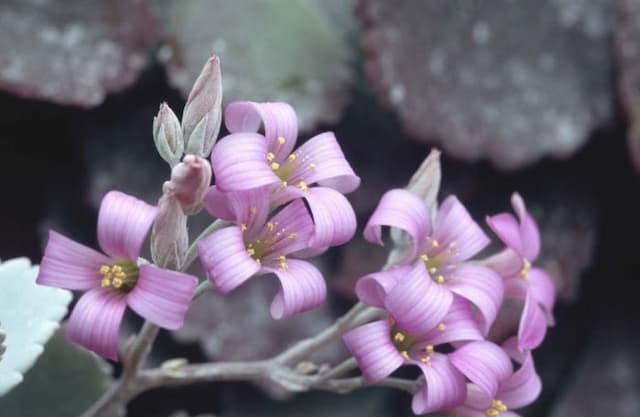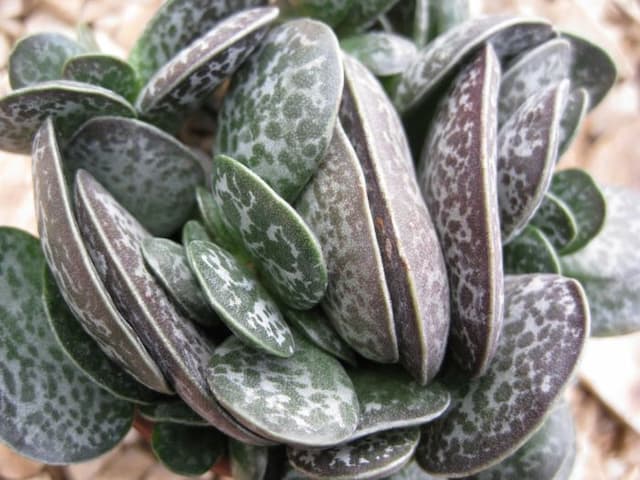Baby's Necklace Crassula rupestris

ABOUT
The commonly known plant Crassula rupestris, also known as Kebab Bush or Rosary Vine, is a succulent with a distinct appearance. It features fleshy, glossy leaves that are arranged in a unique overlapping pattern reminiscent of the beads on a rosary. The leaves are typically green, which may exhibit red edges or tips that become more pronounced when exposed to ample sunlight or cold temperatures. The leaves of the Kebab Bush are oval-shaped and densely packed along its stems giving it a lush, attractive look. The texture of the leaves can be described as smooth, with a plump and taut surface that reflects the plant’s water-storing capabilities. These leaves grow in pairs opposite each other, and as they spiral up the stem, they create a neat, stacked effect. During flowering seasons, the Kebab Bush produces clusters of petite, star-shaped flowers. The flowers are often a pale pink or white color and add a delicate contrast to the robust greenery of the foliage. These blossoms can appear at the ends of the stems, adding to the overall charm of this succulent. Overall, the Kebab Bush's appearance is compact and symmetrical, making it an excellent choice for container gardens or as a component in succulent arrangements. It also exhibits a hardy nature, which adds to its appeal for enthusiasts who appreciate both the aesthetic and low-maintenance requirements of this plant.
About this plant
 Names
NamesFamily
Crassulaceae
Synonyms
Kebab Bush, Rosary Vine, Concertina Plant, Baby's Necklace
Common names
Crassula rupestris var. monticola, Crassula perfoliata var. rupestris, Crassula rupestris var. marnierana, Crassula marnierana, Crassula rupestris var. commutata.
 Toxicity
ToxicityTo humans
The plant known as red pagoda is not considered toxic to humans. However, like with any non-food plant, ingesting large quantities may cause some degree of digestive discomfort, such as mild nausea or stomach upset due to the plant's fibrous material and natural compounds.
To pets
Red pagoda is also not toxic to pets. It should still be noted that the consumption of non-food plants can potentially lead to gastrointestinal upset in pets, including symptoms like vomiting or diarrhea. If an animal consumes a large amount, it is advisable to monitor for any signs of illness and consult a veterinarian if any concerning symptoms occur.
 Characteristics
CharacteristicsLife cycle
Perennials
Foliage type
Evergreen
Color of leaves
Green
Flower color
White
Height
1-2 feet (30-61 cm)
Spread
1 foot (30 cm)
Plant type
Succulent
Hardiness zones
10
Native area
South Africa
Benefits
 General Benefits
General Benefits- Low Maintenance: Crassula rupestris, commonly known as Kebab Bush, is a succulent plant that requires minimal care, making it ideal for busy or forgetful gardeners.
- Drought Tolerant: As a succulent, it has the ability to store water in its leaves, enabling it to survive long periods without watering.
- Aesthetic Appeal: With its distinctive stacked leaves, it adds architectural interest and visual appeal to gardens, windowsills, and indoor plant collections.
- Easy Propagation: The Kebab Bush can be easily propagated from stem or leaf cuttings, allowing for cost-effective expansion of your plant collection.
- Versatility: It's suitable for growing in containers, rock gardens, as ground cover, and in other settings where its unique form can be showcased.
- Long Lifespan: Being a perennial plant, it can live for many years with proper care, providing long-term enjoyment.
- Attracts Pollinators: When in bloom, its flowers can attract bees and other pollinating insects, supporting local ecosystems.
- Resistance to Pests: Crassula rupestris is generally resistant to pests, making it a hassle-free addition to both indoor and outdoor gardens.
- Adaptability: It can adapt to a wide range of lighting conditions, from full sun to partial shade, though it prefers bright, indirect light.
 Medical Properties
Medical PropertiesThis plant is not used for medical purposes.
 Air-purifying Qualities
Air-purifying QualitiesThis plant is not specifically known for air purifying qualities.
 Other Uses
Other Uses- Crassula rupestris, commonly known as the 'Kebab Bush', can be used in miniature gardens due to its small scale, providing a realistic shrubbery or tree appearance in a diminutive landscape setting.
- In feng shui practices, Kebab Bush is sometimes used to attract wealth and good fortune when placed in strategic locations within the home or office.
- Its unique and ornamental appearance allows for its use in wedding bouquets and table centerpieces, especially in succulent-themed weddings or events.
- As a natural art medium, skilled crafters can prune Kebab Bush into topiaries or other artistic shapes for decorative purposes.
- It can be used in educational settings as a model organism to teach students about CAM photosynthesis, a water-conserving process used by many succulents.
- The plant is also popular among hobbyists for use in terrariums, offering both aesthetic appeal and the ability to tolerate the humid conditions inside closed containers.
- Kebab Bush can be grown as a companion plant in mixed succulent container gardens, where its upright growth habit contrasts nicely with sprawling or rosette-forming species.
- In photography, Kebab Bush is often used as a subject for macro photography due to its intricate leaf patterns and textures.
- The structure of Crassula rupestris provides shelter and climbing opportunities for small invertebrates when grown in a garden setting.
- As a potted plant, it is used as a living gift or 'eco-friendly' alternative to cut flowers that can be enjoyed by recipients for much longer.
Interesting Facts
 Feng Shui
Feng ShuiThe Baby Jade is often associated with prosperity in Feng Shui. To use it effectively, place the Baby Jade in the southeastern section of your home or office, which is considered the wealth area. The Baby Jade's succulent leaves are said to resemble jade coins, symbolizing growth and renewal, which can enhance the energy for wealth and abundance.
 Zodiac Sign Compitability
Zodiac Sign CompitabilityThe Baby Jade is not used in astrology practice.
 Plant Symbolism
Plant Symbolism- Prosperity and Wealth: Crassula rupestris, commonly known as Kebab Bush, is often associated with financial success due to its resemblance to the Jade Plant, which in feng shui is believed to attract wealth.
- Good Luck: This plant is also considered to be a symbol of good luck, which makes it a popular gift for new business owners or to be placed in homes as a sign of future prosperity.
- Friendship: As a hardy and resilient plant that's easy to care for, the Kebab Bush is sometimes given as a token of long-lasting friendship, symbolizing the enduring bonds between people.
- Harmony and Balance: The symmetrical and orderly growth pattern of the Kebab Bush represents stability, making it a plant that embodies harmony and balance in one's environment.
 Water
WaterThe watch chain plant requires minimal watering as it is a succulent. Water it every 2-3 weeks, allowing the soil to dry out completely between waterings. When watering, soak the soil thoroughly until water runs out of the drainage holes, which might take around 16 ounces, depending on the pot size. Avoid waterlogging as it can lead to root rot. Cut back on watering to once a month during the winter dormancy period.
 Light
LightThe watch chain plant thrives in bright, indirect sunlight. It's best to place the plant in a location where it can receive plenty of light without being exposed directly to the harsh midday sun, which can scorch its leaves. A spot near a south-facing or east-facing window is ideal for providing the right amount of sunlight.
 Temperature
TemperatureThe watch chain plant prefers temperatures between 60-75 degrees Fahrenheit. It can tolerate a minimum temperature of 40 degrees Fahrenheit but should not be subjected to freezing conditions. The ideal temperature range promotes healthy growth and flowering. Ensure the plant is protected from drafts and drastic temperature changes which can stress the plant.
 Pruning
PruningPruning the watch chain plant helps to maintain its shape and encourage fuller growth. Lightly prune or pinch back the tips of the plant during spring or early summer, which is its active growing phase. If the plant becomes leggy, cut back to just above a leaf node to promote bushier growth. Do not over-prune as this can stress the plant.
 Cleaning
CleaningAs needed
 Soil
SoilFor the Baby's Necklace (Crassula rupestris), use a well-draining soil mix composed of one-third potting soil, one-third coarse sand, and one-third pumice or perlite. The plant prefers a slightly acidic to neutral pH, ranging from 6.0 to 7.5.
 Repotting
RepottingThe Baby's Necklace should be repotted every two to three years or when it outgrows its current container. Choose a slightly larger pot to allow for growth.
 Humidity & Misting
Humidity & MistingThe Baby's Necklace thrives in low to moderate humidity levels. It is tolerant of dry indoor environments and does not require high humidity.
 Suitable locations
Suitable locationsIndoor
Place in bright light, away from drafts.
Outdoor
Grow in part sun; protect from frost.
Hardiness zone
9-11 USDA
 Life cycle
Life cycleCrassula rupestris, also known as Kebab Bush, begins its life cycle when seeds germinate, typically in well-draining soil with some warmth and light. The seedlings quickly establish themselves, developing succulent leaves that store water, adapting well to arid conditions. As the plant matures, it forms a woody stem and grows in a sprawling or stacked fashion, with clusters of fleshy, green to red-tinted leaves. The Kebab Bush may produce small, star-shaped flowers in clusters during the growing season if conditions are optimal, usually requiring bright light and a slight drop in temperature. Once pollinated, possibly by insects, the flowers turn into seed capsules that eventually dry and release new seeds to start the cycle anew. The plant can also propagate vegetatively through leaf cuttings or offsets, which root easily and grow into new plants.
 Propogation
PropogationPropogation time
Spring-Early Summer
The most common method for propagating Crassula rupestris, commonly known as Keeled-leaf Crassula, is through leaf cuttings. To do this, a healthy leaf is gently twisted off the stem, ensuring that it is a clean pull with no part of the leaf left on the stem. The leaf cutting should then be allowed to callous over for a few days to a week, which helps prevent rot when it is potted. Once the cut end has dried and formed a callous, the leaf can be placed on top of a well-draining soil mix, gently pressing it in just enough to make contact with the soil. The soil should be kept slightly moist but not wet, with watering roughly equivalent to a couple of tablespoons (30 ml) around the cutting to ensure the soil is damp but not soggy. In a few weeks to a couple of months, roots will emerge, followed by the growth of new shoots, indicating successful propagation.









